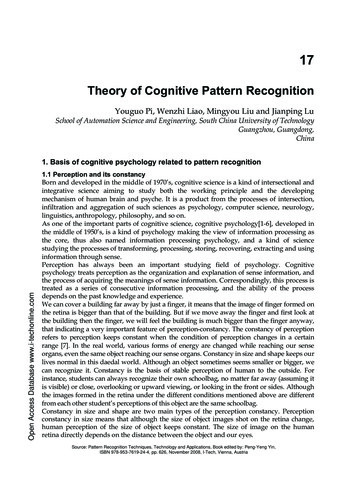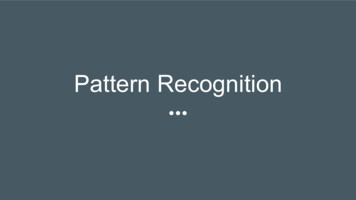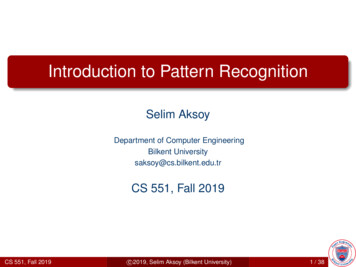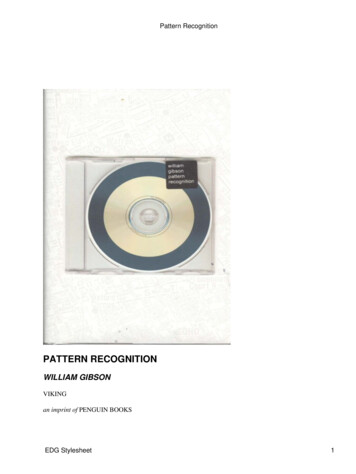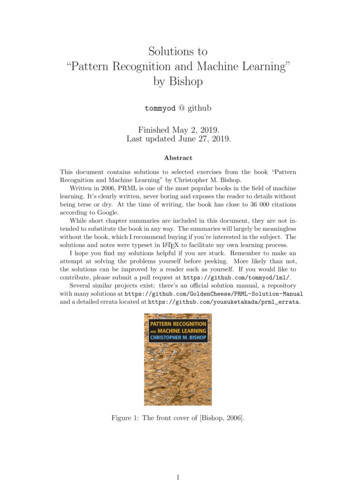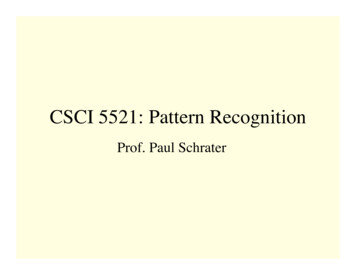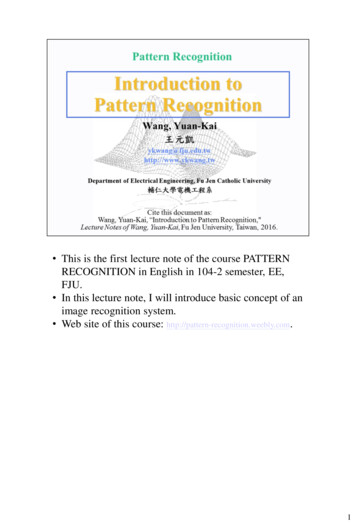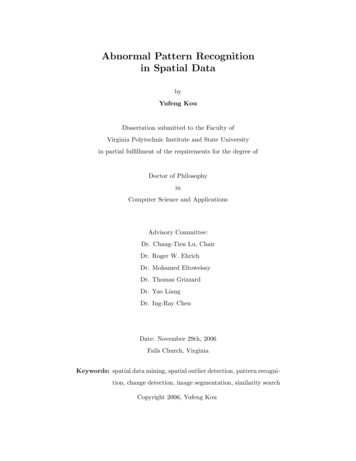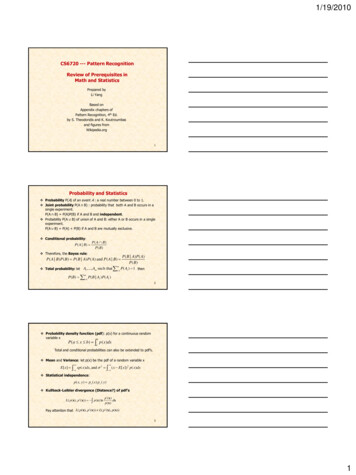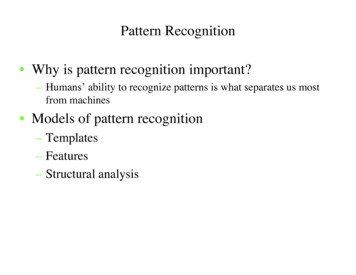
Transcription
Pattern Recognition Why is pattern recognition important?– Humans’ ability to recognize patterns is what separates us mostfrom machines Models of pattern recognition– Templates– Features– Structural analysis
The Mystery of Pattern Recognition
Templates
Templates Match observed object to stored images- “A” is recognized by matching it to stored photographlike image of previously seen “A” Problems– Too many templates needed One template for “A” is probably not enough Need a template for “A” with a specific size, orientation,color, etc. Can this problem be solved with pre-processors?– Ignores intuition that objects are composed of smallerparts
Feature Analysis Recognize an object by breaking it downinto features– “A” is recognized by combining evidence for \ - / Evidence for feature analysis– Neural feature detectors have been found– Simple and conjunctive feature search tasks Simple features are detected in parallel, but combiningfeatures requires attention to be moved across an image in aserial manner Asymmetries in feature search– Illusory conjunctions
Simple feature searchLook for an “O”TTTTTT OTTTTT TTT TT TTTTT TT T T TTTTT T T T
Simple feature searchLook for something redOTTTOT O TTTOTOTOTT OO T TO TT OO OT OOT T
Conjunctive feature searchLook for a red “O”O TT OTT T OTTTOT O T OOT OTTTOTOT O TO OOTOT O T
Conjunctive feature searchLook for a red “O”T O TTTT O TOT TOTO O
Response TimeConjunctive SearchPop-outSimple feature searchNumber of Stimuli in Display
Feature Integration Theory Simple features can be detected anywhere in adisplay, in parallel– Pop-out: for a simple feature search task, response time doesn’tdepend on how many objects are in the display Conjunctions of features require attention to bind(“glue”) the features together– Attention must be deployed serially, to one object at a time– Attention as the force that glues otherwise free-floating featurestogether– For a conjunctive search task, response increases linearly withnumber of objects
Disjunctive and conjunctive feature search tasksNegative “Absent”Positive “Present”Display size # of distractorsConjunctive task: Target is anyobject that is green AND “S”Disjunctive task: Target is anyobject that is green OR “S”Why is disjunctive task a bettercontrol for conjunctive task thana simple feature search like“target is anything green”?
Interpreting Slopes and InterceptsThe relation between display sizeand reaction time is well describedby a line.Slope number of millisecondsrequired per item in displayIntercept amount of timerequired if there were NO items.Flat line “Pop out” displaysize does not influence responetime simultaneous detection of asimple feature everywhere withina display
Why is the conjunctive “Absent”slope twice the conjunctive“Present” slope?Why is there “pop-out” fordisjunctive “present” judgmentsbut not “absent” judgments?
Replication of Treisman & Gelade (1980) Variables––––Task: Conjunctive or DisjunctiveTarget type: Present or AbsentDisplay size: 1 X 1, 2 X 2, 4 X 4, 6 X 6Dependent variable: Response Time and % Correct Predictions– Conjunctive response time Disjunctive response time– Interaction between task and display size Display size matters more for conjunctive than disjunctive tasks– 2-to-1 slope ratio between conjunctive present and absent tasks– Interaction between task, display size, and target type?
Experimental Details Tasks– Conjunctive Target: Green T Distractors: Red T, Green X– Disjunctive Targets: Red or Green S, Blue T or Blue X (anything S OR Blue) Distractors: Red T, Green X Display sizes: 1 X 1, 2 X 2, 4 X 4, 6 X 6 Number of trials– 400 total, so 400/(4 array sizes)/(2 tasks) 50 trials per block– 50 trials 25 present and 25 absent trials Add jitter: 5 pixels (1 pixel .034 cm) Appearance: Helvetica 24 Order of 8 conditions: randomized for each participant
The Cleveland FontpictureKey* ,-./0123456789:; ?@ABCDEFGHIJKLMNOPQRSTUVWXYZ[\] abcdefghijklmnopqrstvwyzux
Feature search asymmetriesIt is easier to find X among Ys than Y among Xs if X has an extrafeature compared to Y.Find the OQQQQQ QQQ QQQ QOQQ QQQQ QFind the QOO OOOOOO Q OO OOOO O OO OO
Illusory ConjunctionsWhen attention cannot be used to bind features togetherbecause displays are too fast, then features free-floatindependently, and may incorrectly recombine with each other.
Structural Analysis Represent parts, and relations between parts Geon theory– A fixed number of primitive geometric components– Composed in different arrangements to create all objects Evidence for geons– Object recognition is hard if object cannot be analyzed intogeons
Combining geons to create objects36 geons in all
Relations between parts is important
Recognition is easier when geons can be recovered
Practice does not improve Display Size X RTslope for color-form conjunctive taskPeople do not form colorform units over time
Similarity of Targets to Distractors is not thecritical factor for determining search easeWhat matters iswhether a simplefeature can be usedto detect a targetWell-learnedconjunctions arestill recognized bycombining theirfeatures.We do not form an“R” unit?
Shiffrin & Lighfoot (1997)Units made of simple line segmentscan be created with practice
Unitization of complex forms (Goldstone, 2000)Category 1Category 2ABCDZABCDEABCYEAll task: Need to pay attentionto A, B, C, D, and EOne task: Only need to attendone of the five segmentsABXDEAWCDEVBCDE
Responses to a conjunctive target with 20 hours of 1,5001,500500500P.T.C.E .BlocksBlocks
Holism revisited - Holistic “sameness” detector?Task 1: Are these two grids cell-for-cell identical?Task 2: Do these grids have any cells in common?NoYes"Yes" judgments for Task 1 are faster than "Yes"judgments for Task 2, even though, logically (in onesense), Task 1 requires many Task 2-type judgments.
Expertise creates new perceptual units (Gauthier et al, 1999)
Fusiform gyrus (IT) activity due to novel stimuli (Gauthier et al, 1999)
Differences in object recognition due to expertise occur within 170msec of stimulus onset (Curran & Tanaka, 2001)
Holism as interactions between parts (Farah, 1992)Which is Larry’s nose? (Part judgment)Part in whole judgmentis much easier than partjudgment for facesWhich is Larry’s face? (Part in whole judgment)Faces are holisticallyperceived
Tanaka & Farah (1993)
Feature Search for RaceThe influence of life-long experience on face perception
Feature search task performance is more efficient with “other race”targets than “same race” targets (Levin, 2000)
Conclusions There is strong evidence for an analytic account ofpattern recognition– Parallel detection of features– Combining features together takes time and attention– Early perception of an object is as a “bag of features” Holistic perception also occurs– Perception of entire forms without decomposition– Unitization of well-learned forms– Context effects on perception of features Open Question– When do analytic and holistic perceptual processes occur?– What does it mean to be a psychological feature?
pattern recognition –Parallel detection of features –Combining features together takes time and attention –Early perception of an object is as a “bag of features” Holistic perception also occurs –Perception of entire forms without decomposition –Unitization of well-lea
